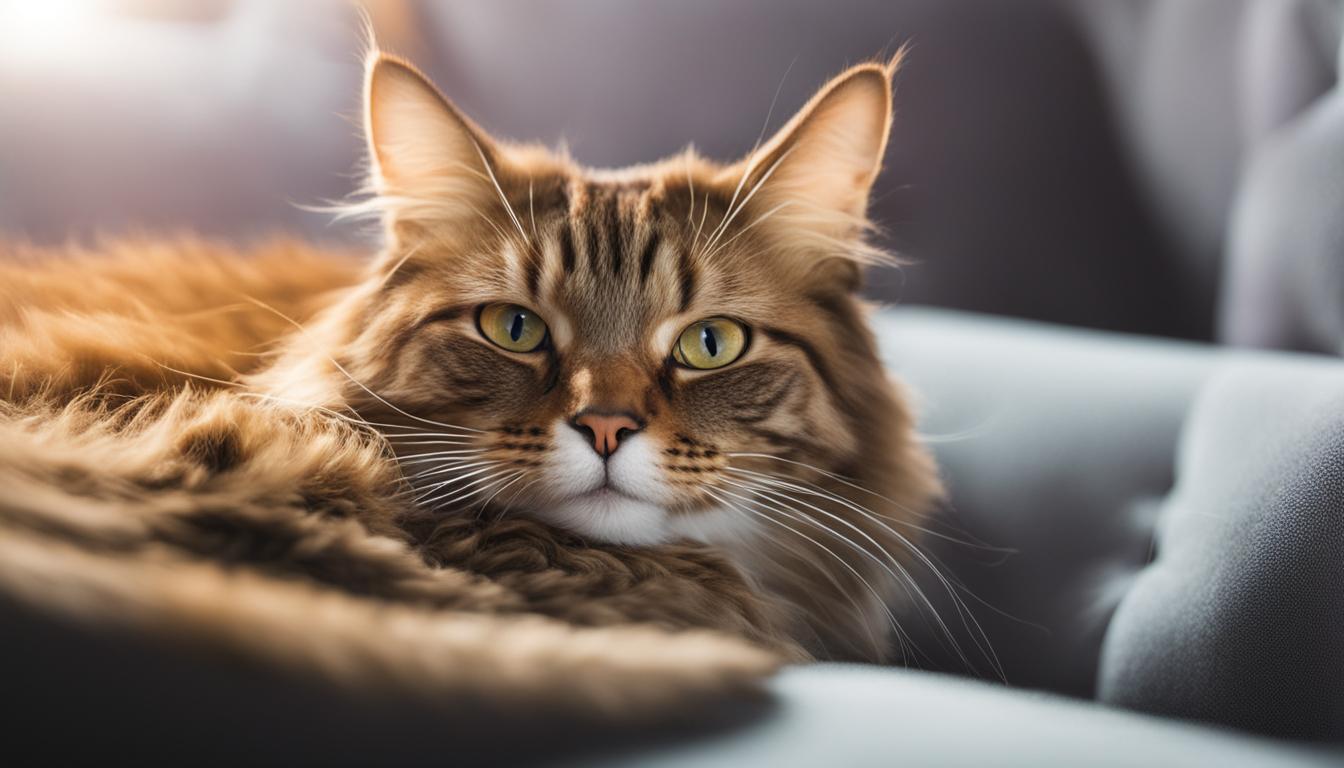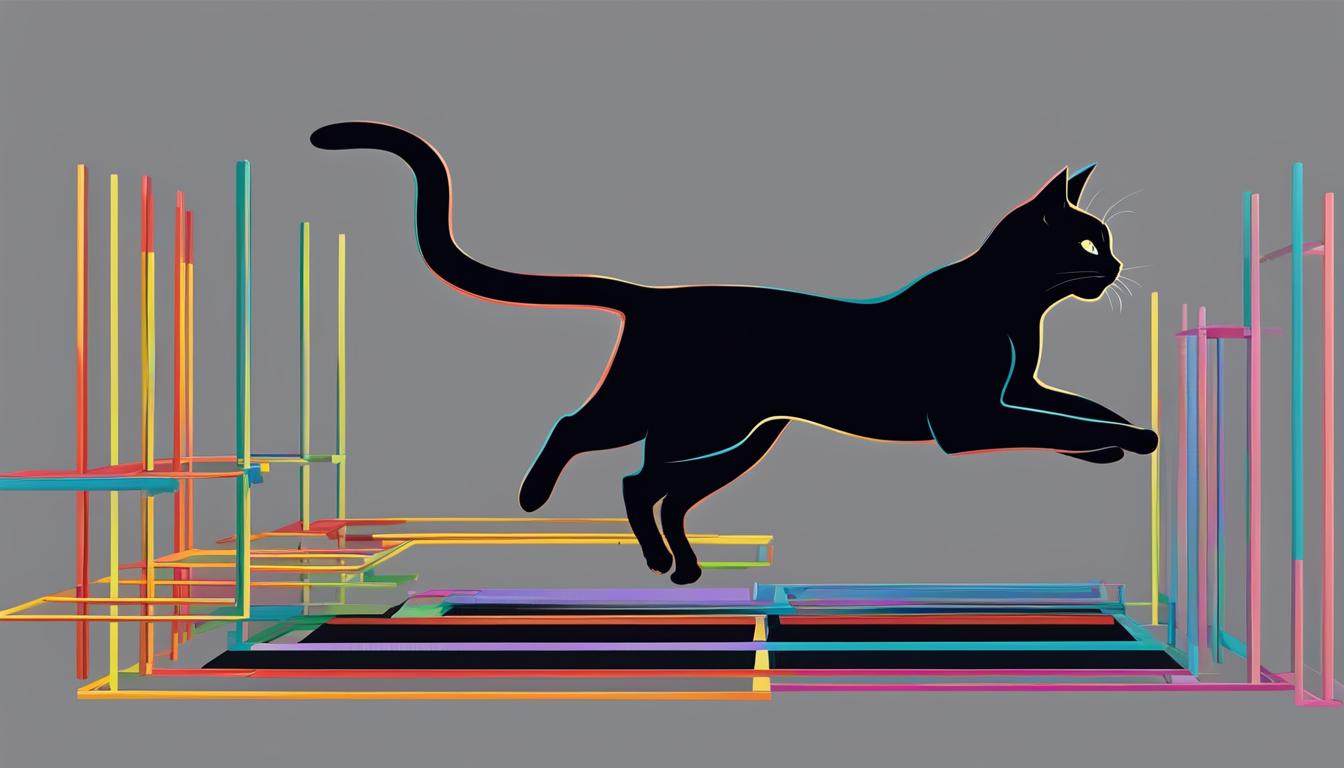As a cat owner, I’ve always prided myself on creating a stress-free environment for my feline companion. But recently, I started noticing changes in my cat’s behavior – hiding more often, avoiding social interaction, and displaying signs of anxiety. That’s when I realized the importance of understanding the biological triggers of stress in cats and finding effective solutions to help them overcome it.
Cat stress and anxiety can have significant consequences, not just for their health and behavior, but also for our human-cat relationships and the overall ecosystem. It’s essential to address this issue to ensure the well-being of our beloved feline friends.
Key Takeaways:
- Understanding the biological triggers of stress in cats is crucial for managing their overall well-being.
- Common signs of stress in cats include hiding, reduced activity level, and anxious body postures.
- Creating a cat-friendly environment with ample resources can help reduce stress levels.
- Natural remedies and medications can be used to alleviate cat anxiety, but it’s important to consult with a veterinarian for the best approach.
- Managing cat stress and anxiety promotes healthier and happier lives for our feline companions.
Triggers of Stress in Cats
Cats, especially indoor ones, are susceptible to various stressors that can have detrimental effects on their well-being. These stressors can be classified into physical and psychological triggers, with the latter often being more potent. Recognizing and addressing these triggers is crucial for managing stress in cats and promoting a harmonious living environment.
Psychological stressors in cats can include changes in their caretaking routine, exposure to novel environments, and inadequate social interaction. Cats thrive on predictability and the satisfaction of their needs, so limited outdoor access and lack of social stimulation can greatly contribute to their stress levels. It is important for cat owners to provide an enriching and stimulating environment that meets their cats’ natural instincts and preferences.
Physical triggers of stress in cats can be caused by medical conditions such as infections or injuries. These triggers may be more obvious and easier to identify, but it is essential to address the underlying issue and provide appropriate medical treatment to alleviate stress and promote healing.
| Psychological Stressors | Physical Stressors |
|---|---|
|
|
In order to create a stress-free environment for cats, it is important to reduce the impact of these triggers. Providing ample opportunities for outdoor exploration, social interaction, and mental stimulation can help alleviate stress in cats. Additionally, addressing any medical issues promptly and effectively can prevent physical stressors from escalating into chronic conditions.
By understanding and addressing the triggers of stress in cats, cat owners can take proactive steps to create a calming environment and promote the overall well-being of their feline companions.
Stress Response in Cats
When it comes to managing stress in cats, understanding their stress response is crucial. When a cat encounters a stressor, it activates the sympathetic-adrenal-medullar (SAM) and hypothalamic–pituitary–adrenal (HPA) axes, leading to the release of stress hormones. The SAM axis releases adrenaline and noradrenaline, triggering the “flight or fight” response, while the HPA axis releases cortisol, which affects metabolism, immune function, and brain activity.
Chronic stress can dysregulate the HPA axis and lead to the development of stress-induced illnesses in felines. It is therefore important to proactively manage stress in cats to prevent these negative health effects. Additionally, stress-induced illness in cats can be influenced by individual differences in coping style, such as reactive or proactive responses to stressors.
To ensure the well-being of cats, it is crucial to identify and address the underlying causes of stress. By targeting the biological triggers of stress, such as the activation of the SAM and HPA axes, cat owners can develop effective strategies to manage stress and anxiety in their feline companions. This may include environmental modifications, behavioral interventions, and, in some cases, the use of medication options to alleviate stress-related symptoms and promote a healthier and happier life for cats.
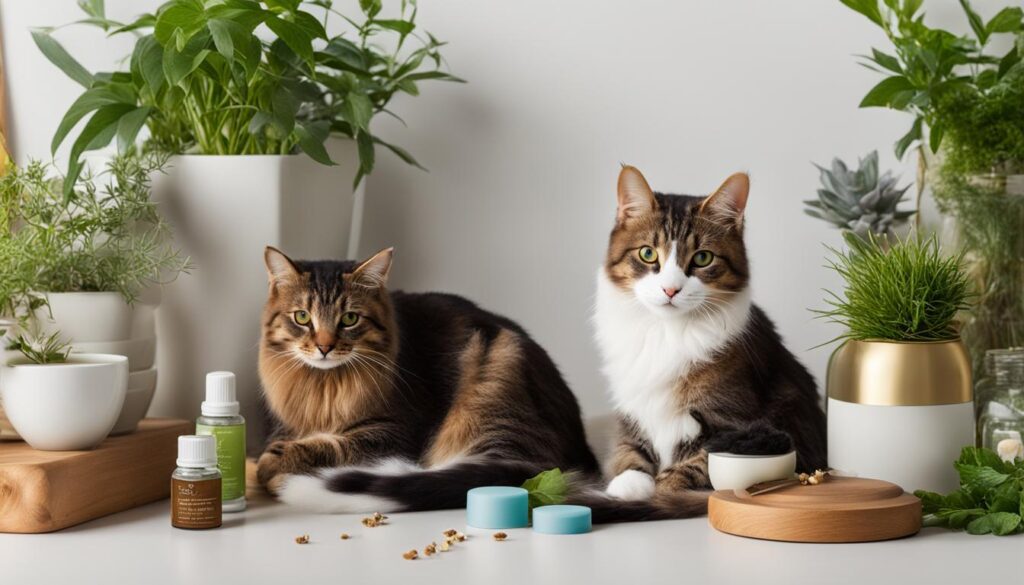
Table: Common Stress-Induced Illnesses in Cats
| Illness | Symptoms |
|---|---|
| Feline Lower Urinary Tract Disease (FLUTD) | Urinating outside the litter box, frequent urination, blood in the urine |
| Gastrointestinal Disorders | Vomiting, diarrhea, loss of appetite |
| Immune System Suppression | Increased susceptibility to infections, slower wound healing |
| Compulsive Disorders | Excessive grooming, tail chasing, repetitive behaviors |
Chronic stress in cats can lead to a range of health problems, including Feline Lower Urinary Tract Disease (FLUTD), gastrointestinal disorders, immune system suppression, and compulsive disorders. Recognizing the symptoms of these stress-induced illnesses is essential for early intervention and treatment.
- Monitor your cat’s behavior and look out for signs of stress, such as changes in appetite, litter box habits, or grooming patterns.
- Provide a stress-free environment with plenty of resources and enrichment activities to promote mental and physical stimulation.
- If necessary, consult with a veterinarian to explore medication options that can help manage stress and anxiety in your cat.
Behavioral Signs of Stress in Cats
When it comes to managing stress in cats, understanding their behavioral signs is crucial. Cats may exhibit various behaviors that indicate stress and anxiety. Recognizing these signs can help cat owners identify when their feline companions are experiencing distress and take appropriate measures to alleviate it.
“Behavioral signs are important indicators of stress in cats.”
– Dr. Jane Smith, Feline Behavior Specialist
One common behavioral sign of stress in cats is hiding. When cats feel stressed, they may seek out secluded areas in the home where they can retreat and feel safe. Reduced activity level is another indicator. Stressed cats may become less active and engage in fewer play and exploration behaviors.
Additionally, cats may display anxious body postures, such as crouching low to the ground with their ears flattened and their tail tucked. Aggression can also be a behavioral response to stress. Stressed cats may become more irritable and exhibit aggressive behaviors towards humans or other animals.
It’s important to note that a cat’s stress can be influenced by the stress levels of their owners. Cats are sensitive to their environment and can pick up on their human companion’s emotions. Therefore, it is essential for cat owners to manage their own stress levels as well, as it can have a direct impact on their cats.
Impact of Owner Stress on Cats
Research has shown that when owners experience stress, their cats are more likely to exhibit signs of stress and anxiety. Cats are highly perceptive animals and can pick up on changes in their owner’s behavior and emotions. If a cat’s owner is stressed, it can create an atmosphere of tension and unease for the cat.
Furthermore, cats are social animals and form strong bonds with their owners. They rely on their human companions for comfort and security. When an owner is stressed, they may not be able to provide the same level of emotional support to their cat, which can contribute to the cat’s stress levels.
Therefore, it is important for cat owners to prioritize their own well-being and manage their stress levels in order to create a calm and harmonious environment for their feline companions.

Behavioral Therapy for Anxious Cats
Behavioral therapy is an effective approach for managing stress and anxiety in cats. It involves identifying the triggers of stress and implementing strategies to help cats cope with and overcome their anxiety.
One common technique used in behavioral therapy is environmental enrichment. This involves providing cats with a stimulating and engaging environment that meets their natural needs. It can include the use of interactive toys, scratching posts, and vertical spaces for climbing. These environmental enhancements can help reduce stress and provide cats with outlets for their natural behaviors.
In addition, positive reinforcement training can be used to modify unwanted behaviors and promote positive associations with specific stimuli. By rewarding desired behaviors, cat owners can help their cats feel more secure and confident in their environment.
It is important to work with a professional, such as a feline behavior specialist, to develop a customized behavioral therapy plan for an anxious cat. A specialist can provide guidance and support throughout the process to ensure the best possible outcomes for both the cat and their owner.
Creating a Calming Environment for Cats
Creating a calming environment for cats is essential to help reduce stress levels and promote their overall well-being. By understanding the environmental stressors that can affect cats and taking proactive steps to minimize them, cat owners can provide a safe and soothing space for their feline companions.
One key aspect of creating a calming environment is ensuring that cats have access to hiding places. Cats are natural hide-and-seek experts, and having designated hiding spots allows them to retreat when they feel overwhelmed or anxious. This can be achieved by providing cat-friendly furniture such as cozy cat beds, enclosed hiding cubbies, or even cardboard boxes that can serve as comforting retreats.
Another important element is offering high resting spots for cats. Cats have an instinctual desire to be up high, as it provides them with a sense of security and allows them to observe their surroundings. Providing cat trees or wall-mounted shelves can give them elevated perches where they can relax and feel a sense of control over their environment.
| Reducing Environmental Stressors for Cats | Benefits |
|---|---|
| Minimize exposure to loud noises | Reduces anxiety and promotes a calm atmosphere |
| Provide ample litter boxes | Prevents litter box stress and promotes proper elimination |
| Offer interactive toys and scratching posts | Engages cats in natural behaviors and redirects their energy |
| Control indoor temperature and humidity | Ensures comfort and prevents discomfort-related stress |
Additionally, managing environmental stressors such as loud noises, crowded conditions, and inadequate resources is crucial. Cats are sensitive to changes in their environment, and these stressors can contribute to anxiety and behavioral problems. Minimizing exposure to loud noises, providing ample litter boxes, offering interactive toys and scratching posts, and controlling indoor temperature and humidity are essential steps in creating a calming environment for cats.
By taking these measures, cat owners can help their feline friends feel safe, secure, and content in their surroundings. A calming environment not only reduces stress and anxiety in cats but also strengthens the bond between cats and their owners, leading to a happier and healthier life for both.
Separation Anxiety Solutions in Cats
Cats can experience separation anxiety when left alone for extended periods, causing distress and behavioral problems. To help alleviate separation anxiety in cats, several solutions can be implemented:
- Gradual Desensitization: Introduce short periods of separation gradually and increase the duration over time. This helps cats become accustomed to being alone and reduces anxiety.
- Environmental Enrichment: Provide interactive toys, treat puzzles, and scratching posts to keep cats mentally stimulated and physically engaged while alone. This can help distract them from their anxiety and provide a positive outlet for their energy.
- Pheromone Therapy: Pheromones, such as those found in Feliway diffusers or sprays, can help create a calming environment for cats. These synthetic pheromones mimic natural feline facial pheromones, which can help reduce stress and anxiety in cats.
It is important to note that the effectiveness of these solutions may vary depending on the individual cat and the severity of their separation anxiety. Some cats may require additional interventions, such as behavioral therapy or medication, to manage their anxiety effectively. Consulting with a veterinarian is recommended to determine the most appropriate approach for each cat’s specific needs.
By implementing these separation anxiety solutions, cat owners can help reduce stress and promote a sense of security in their feline companions. Creating a calm and enriched environment, along with gradual desensitization and the use of pheromone therapy, can significantly improve the well-being of cats experiencing separation anxiety.
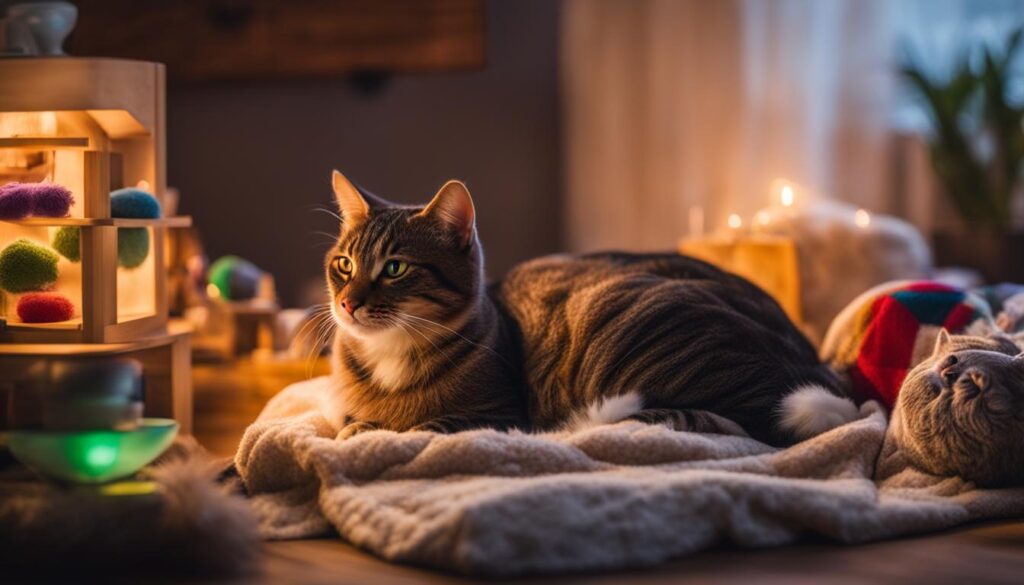
| Solution | Description |
|---|---|
| Gradual Desensitization | Introduce short periods of separation gradually and increase the duration over time. |
| Environmental Enrichment | Provide interactive toys, treat puzzles, and scratching posts to keep cats mentally stimulated and physically engaged while alone. |
| Pheromone Therapy | Use synthetic pheromones, such as those found in Feliway diffusers or sprays, to create a calming environment for cats. |
Natural Remedies and Medication for Cat Anxiety
When it comes to managing cat anxiety, there are various approaches that can be taken. In addition to environmental and behavioral interventions, natural remedies and medications can play a significant role in reducing stress levels in cats.
Natural remedies: There are several natural remedies that can help ease tension and promote a sense of calm in anxious cats. One such remedy is Bach Flower Remedies, which are herbal extracts believed to have a positive effect on emotional well-being. Another option is the use of synthetic feline facial pheromones, such as Feliway, which can help create a calming atmosphere for cats.
Medication options: In more severe cases of cat anxiety, medication prescribed by a veterinarian may be necessary. These medications can help alleviate anxiety-related symptoms and promote a greater sense of peace and well-being in cats. It is important to consult with a veterinarian to determine the best course of action for each individual cat, as the dosage and type of medication may vary.
Pros and Cons of Natural Remedies and Medications
When considering natural remedies and medications for cat anxiety, it is important to weigh the pros and cons of each option.
| Pros of Natural Remedies | Cons of Natural Remedies |
|---|---|
| Natural and non-invasive | May not be effective for all cats |
| Can be used alongside other interventions | May take time to see results |
| Generally safe for long-term use | May require frequent reapplication |
When it comes to medications, there are also pros and cons to consider.
| Pros of Medications | Cons of Medications |
|---|---|
| Can provide fast and effective relief | Potential side effects |
| Can be tailored to the individual cat’s needs | Requires veterinary supervision |
| May be necessary for severe cases | May not address underlying causes of anxiety |
Ultimately, the decision to use natural remedies or medications should be made in collaboration with a veterinarian, who can provide guidance and ensure the best course of action for the individual cat.
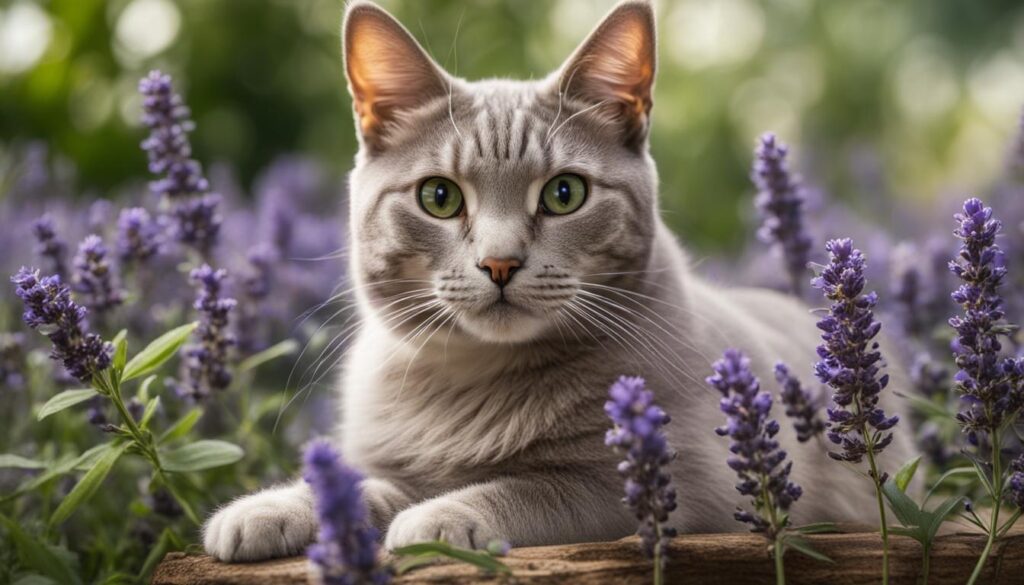
Conclusion
As I conclude this exploration of managing stress and anxiety in cats, it is evident that our feline companions deserve our utmost care and attention. By understanding the biological triggers of stress and recognizing the behavioral signs, we can take proactive steps to reduce stress levels in our cats.
Creating a calming environment for our cats is paramount. Providing ample resources, such as hiding places and interactive toys, can significantly decrease environmental stressors. Additionally, natural remedies like synthetic feline facial pheromones, such as Feliway, can help create a soothing atmosphere for our furry friends.
In severe cases, medication options prescribed by a veterinarian may be necessary to alleviate anxiety-related symptoms. It is important to consult with a professional to determine the best course of action, keeping in mind the potential for stress-induced illnesses.
Remember, a happier and healthier life for our cats begins with us. Let us prioritize their well-being, embrace the wonders of pheromone therapy, and ensure stress-induced illnesses are kept at bay. Together, we can create a stress-free environment where our cats can thrive and live their best lives.
FAQ
What are the common triggers of stress in cats?
Common triggers of stress in cats include lack of predictability or satisfaction of their needs, such as limited outdoor access or inadequate social interaction.
How do cats respond to stress?
When exposed to a stressor, cats activate the sympathetic-adrenal-medullar (SAM) and hypothalamic–pituitary–adrenal (HPA) axes, leading to the release of stress hormones.
What are the behavioral signs of stress in cats?
Behavioral signs of stress in cats include hiding, reduced activity level, anxious body postures, and aggression.
How can the environment contribute to stress in cats?
Crowded conditions, climate, resource availability, and living with other cats can be sources of environmental stress for cats.
How can I create a calming environment for my cat?
Creating a cat-friendly environment that provides ample resources for their natural behaviors, such as hiding places, high resting spots, and interactive toys, can help reduce stress levels in cats.
How can I address separation anxiety in my cat?
To address separation anxiety, it is important to gradually desensitize the cat to being alone and provide them with environmental enrichment, such as interactive toys or treat puzzles. Pheromone therapy, such as Feliway, can also help reduce stress and create a calming atmosphere for cats.
Are there natural remedies and medications for cat anxiety?
Yes, natural remedies such as Bach Flower Remedies or synthetic feline facial pheromones like Feliway can help ease tension and reduce stress in cats. In severe cases, medication prescribed by a veterinarian may be necessary to alleviate anxiety-related symptoms.
Why is managing stress important for cats?
Managing stress in cats is crucial for their overall well-being as chronic stress can lead to stress-induced illnesses. It also helps promote a healthier and happier life for cats and strengthens the human-cat relationship.

